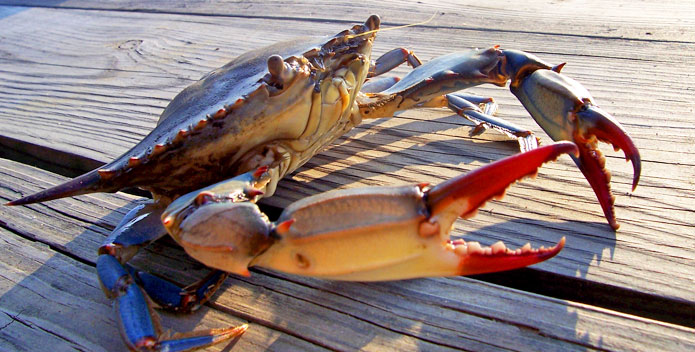Welcome to the dog days of summer! Around the Chesapeake Bay, this is also crab feast season. There is nothing better than a cracking open a cold one on a hot summer day and indulging in this fine regional culinary treat. But...how are the crabs doing this year? The survey says a "positively mixed bag"—read on to discover how we got these results, and how you can help keep these crucial crustaceans around.
How are crabs counted? Easy—science. Every winter since 1989, Maryland's Department of Natural Resources and the Virginia Institute of Marine Science have collaborated to measure the population using crab dredges deployed from boats.
How does a crab dredge work? A crab dredge is deployed for one minute across the floor of the Bay at 1500 randomly selected sites. The crabs are caught in their winter slumber (when they are more docile), counted, and sorted into categories based on age, size, and maturity.
Where does the data go? Scientists combine the data from the two states and use statistical software to provide estimates of the Bay-wide population.
What does the data tell us? The results estimate how many crabs are in the Bay, as well as the age structure of the population. The information helps determine the appropriate seasons for the current year, the harvest limits for the following season, and how we can ensure a healthy crab population over the long term.
What happens next? Data first, then decisions. After the results are released in the spring, the data is reviewed, and adjustments are made by scientists, regulators, and other stakeholders.
And the survey says...
A Positively Mixed Bag: The 2017 winter dredge survey results for Bay crabs, released in mid-April, were a mixed bag showing a continuing positive trend overall. Spawning age females were at a record level, but juvenile numbers fell well below the long-term average, and adult males also diminished.
What does this mean? Maryland and Virginia shortened the commercial season calendar and reduced harvest limits for females to keep moving in the right direction. The intention is to protect the smaller population of juvenile crabs as they reach market size, and so that they will be around to reproduce next year.
This also means that while we are seeing some improvements due to the Chesapeake Clean Water Blueprint, we must also keep this vital plan in place to ensure our fisheries can flourish. We see this plan working with underwater grasses, which are not only vital habitat for crabs but are also at their highest levels in 30 years.
If we continue to follow the science on crabs and water quality, the crabbing industry and family crab feasts will remain treasures of the Chesapeake for generations to come. Help keep this legacy alive and sign our blue crab petition today!
Alice Christman
Issues in this Post
Fisheries Bay Grasses Blue Crabs Chesapeake Clean Water Blueprint Conservation Fishing Habitat Loss CBF in Maryland CBF in Virginia



